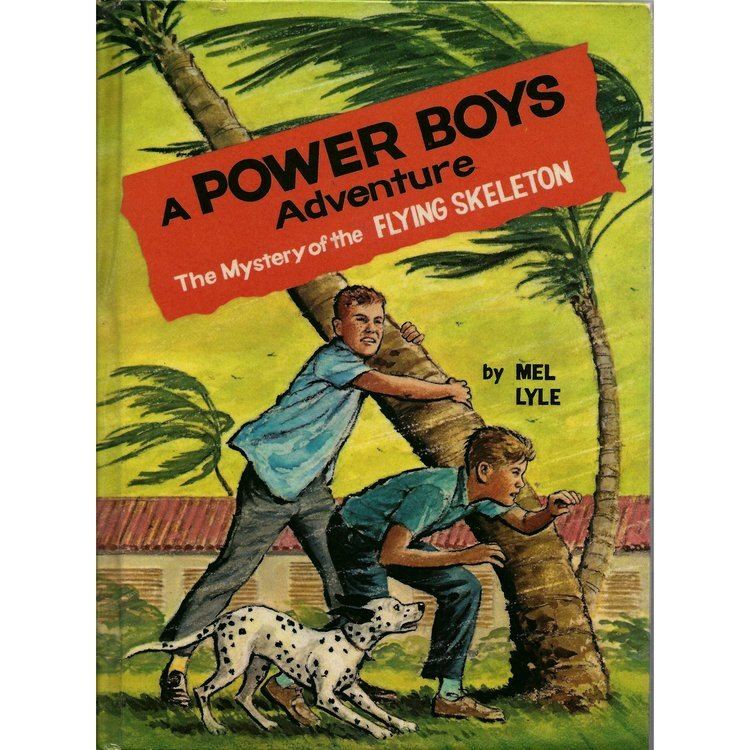 | ||
Similar Biff Brewster, Bronc Burnett, Tom Quest, Tom Swift Jr, Chip Hilton | ||
The Power Boys are two fictional brothers in a series of six children's novels by Mel Lyle, published in the mid-1960s by Whitman Publishing.
Contents
The characters
The two boys, Jack and Chip Power, aged 17 and 15 respectively, with their Dalmatian, Blaze, live with their photojournalist father Thomas, their mother having died before the events in the first book. Jack and Chip travel with Mr. Power, and get involved in various adventures in which they act as detectives, track down criminals and end up in various dangerous situations.
The books feature brief descriptions of the characters' appearance. Jack is described as tall and slender, with reddish-brown hair cut short, and he has green eyes and freckles; Chip is slim, almost as tall as Jack, has blond hair with reddish glints, and his eyes are blue. Jack is portrayed as more serious and dependable, and Chip is more impulsive - sometimes his eyes or face are described as mischievous. Thomas Power is about as tall as Jack, but looks shorter because he is of heavier build. His hair is black and streaked with premature grey. The boys and their father are portrayed as very close to each other.
The stories
For most of the series it is not clear where the family's regular home is, since the books are set in a wide variety of locations within the U.S. Three of the books are set in New York City (nos. 1, 5, and 6), but it is clear in the first two of these that they are merely visiting the city, and do not live there; in the third of these New York books, which is the last in the series, the family has come to live there, because Barry Donovan, a wealthy man who appeared in book five, could supply Thomas Power with a lot of future work. The first paragraph of this last book tells how much the brothers love their new eight room apartment. We also learn that Mrs. Donovan helped with the decorating. There is a single brief mention in the series of their home being or having been in Chicago, but no scene anywhere in the series is set there.
The boys do not appear to have an extended family of aunts, uncles, cousins, or grandparents; or if they do, they are never mentioned even in passing. But Detective James Wilson of the New York Police Department appears or is mentioned in several of the books, not only in his capacity as a police officer dealing with crimes in the books, but is also mentioned as one of Thomas Power's oldest and dearest friends. Detective Wilson plays a role in the boys' lives similar to that of a favorite uncle.
The boys do not seem to have many long-lasting friends in their own age-group (or at least not ones that are mentioned), but do make friendships which last for the duration of a single book. The single exception to this is that the boys do make friends with Dick Donovan, the son of the aforementioned Barry Donovan, in the fifth book (in which Dick plays a prominent role), and the friendship is shown as continuing in the sixth book, although Dick's role in that book is less prominent.
The six books in the series are as follows:
- The Mystery of the Haunted Skyscraper (1964)
- The Mystery of the Flying Skeleton (1964)
- The Mystery of the Burning Ocean (1965)
- The Mystery of the Million-Dollar Penny (1965)
- The Mystery of the Double Kidnapping (1966)
- The Mystery of the Vanishing Lady (1967)
Editions
The books were published with illustrated hard covers, but no dust jackets. Raymond Burns' line illustrations were done in a single color, which varies from book to book. At one time Whitman published paperback (plus paperback-sized hardback "library edition") formats of some of their book series. It is not certain whether or not Power Boys mysteries were available in these smaller formats.
The author
Nothing is known about Mel Lyle. It is unknown whether this is his real name, a pseudonym for a single author, or even a house name for different writers—nor is it known whether he is still alive.
Many of the Whitman series used a pseudonym in place of the actual author's name. William Larson, an editor hired by Whitman in 1964, stated that if more than one book in a series was published in a year, they were almost always written by different people. Since two Power Boys books were published in both 1964 and 1965 it is likely that more than one person wrote the series.
Other Power Boys books
There is another series of children's adventure books referred to as "Power Boys" books. Written by Woody Gelman under the name Arthur Benwood in the 1950s, they antedate Lyle's books. The brothers referred to are different characters (Ted and Steve Power instead of Jack and Chip Power), and Gelman's books would appear to be completely unrelated. Whether Lyle was influenced by this earlier series in his choice of his Power Boys' surname is unknown.
